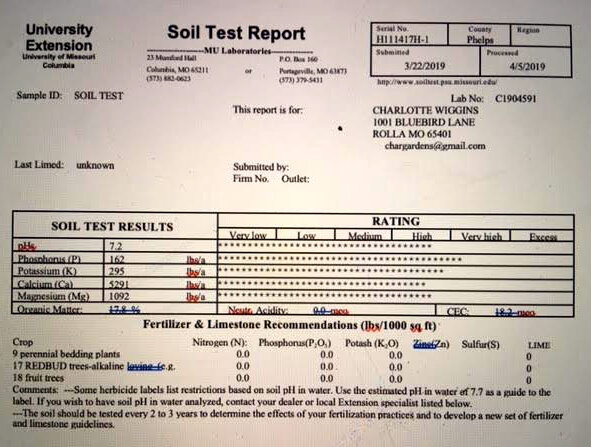How to Test Soil
/The wonderful world of soils and all of the microorganisms that live in it. (Photo by Charlotte Ekker Wiggins)
Soil Testing
As spring fever hits, this is the perfect time to get soil tested. Of all of the things we can do to make our gardens better, getting soil tested is by far the most important step to take.
A test will help assess the current state of soil and make recommendations of how to improve it for what you want to plant.
I did my first soil test through the University of Missouri Extension a couple of decades ago and repeat it every 2-3 years. Working a Missouri limestone hillside into a garden, it’s helpful to monitor how the soil amendments I have added change the soil composition.
Soil is assessed on a scale of 1-14. A middle seven is neutral. The chart extremes are sweet, higher than 7+ and bitter, lower than 7.
To successfully grow most plants, you want a good solid seven. On either end, blueberries and hydrangeas prefer a little more acid growing conditions; butterfly bushes and lilacs prefer sweeter soil.
How to Collect Soil
Using a freezer bag, collect 1 1/2 cups of soil from 6-8 spots around the garden from about 6 inches deep - if you can dig that deep.
Seal it up and take it to your local University of Missouri Extension office with $15. You will need to tell them what kind of plants you want to raise to get the most out of your soil test results.
Within a couple of weeks, the soil test report will be emailed to you with the results and recommendations, as appropriate.
The following are a couple of soil test examples, starting with a home garden.
Example Home Garden Soil Test
This home garden soil test shows recommendations at bottom. (Photo by Charlotte Ekker Wiggins)
The soil test results are a little different for a field soil test.
Example Field Soil Test
A field test soil example covers more elements. (Photo by Charlotte Ekker Wiggins)
My One Acre Limestone Hillside Soil Test April 2019
Over the years, friends have asked how I grow what I grow on a limestone hillside garden, where my first neighbors said “nothing would grow.” For 35 years i have concentrated on adding organic matter to existing soil and being kind to the soil I do have.
My limestone hillside garden soil test from April 2019. (Photo by Charlotte Ekker Wiggins)
How to Improve Soil
At first blush, my Missouri limestone hillside garden should be acidic because I let the oak leaves fall on garden beds and only rake those that get in my way. Leaves, by the way, are excellent mulch and provide winter cover for a number of beneficial insects.
To improve my soil - well, actually to create soil - I added wood chips from our local recycling center along with compost. In addition, shredded leaves with grass clippings were also incorporated. These were added after the wood chips and shredded leaves had sat for a few months.
And to naturally enrich the soil, I have wildlife branch piles that have encouraged rabbits, which add to enriching the soil. And they’re big. I snuck out into my apiary at 4 a.m. to close up a hive a couple of weeks ago and was astounded at the wildlife moving around, including one very large rabbit.
Maybe it was because I was standing down hill and the rabbit was uphill but that was one big “bun bun.”
Regardless of your soil test results, the best way to improve soil is to compost. Compost helps to feed the microorganisms in soil that keep plants healthy. You can start by composting kitchen scraps and gradually move to composters and composting bins. It really is the best thing you can do for your soil and plants!















